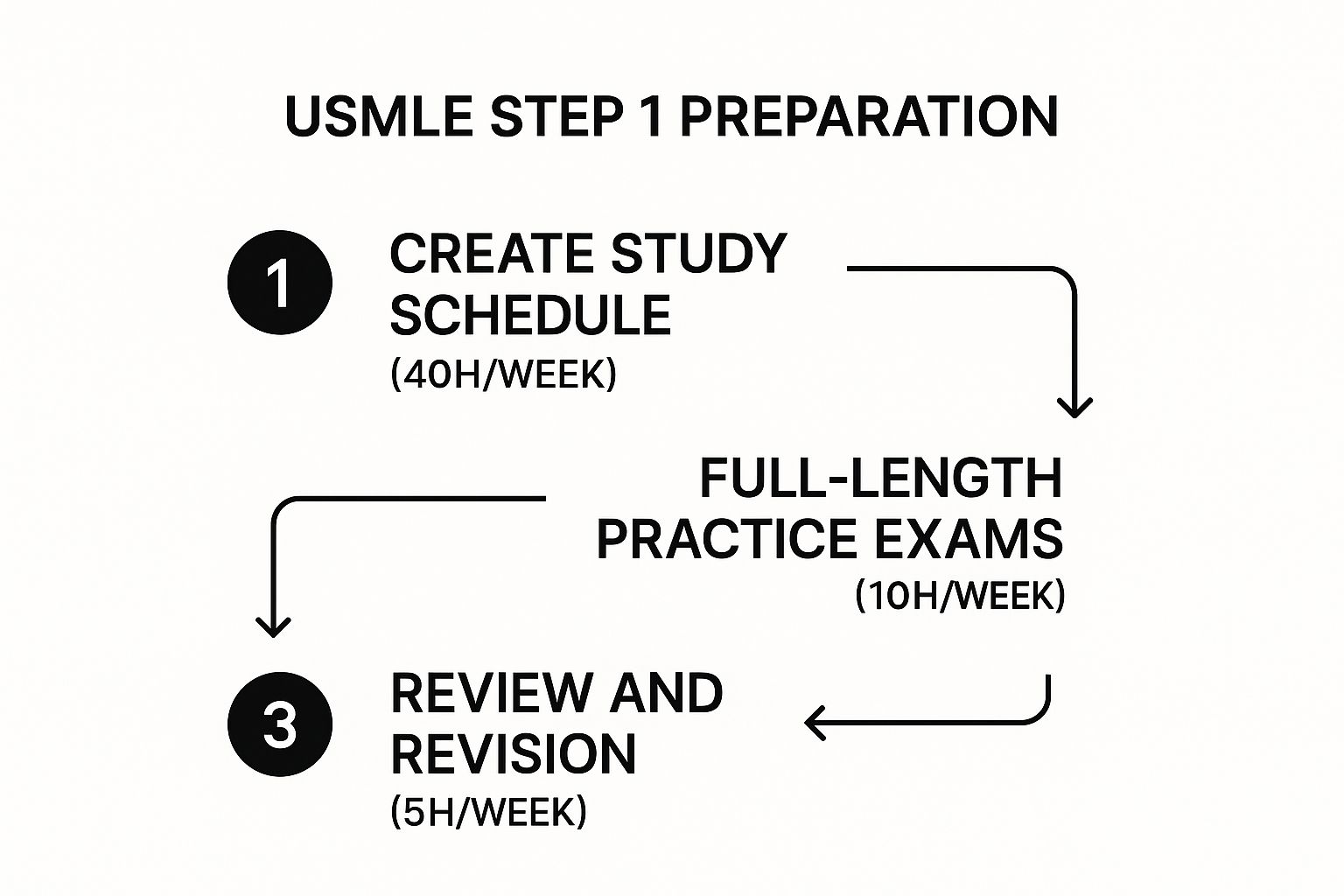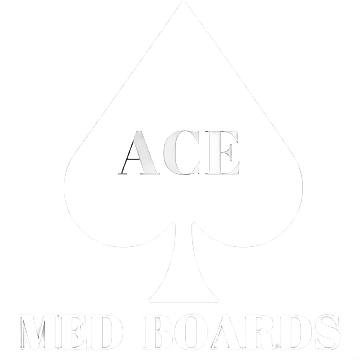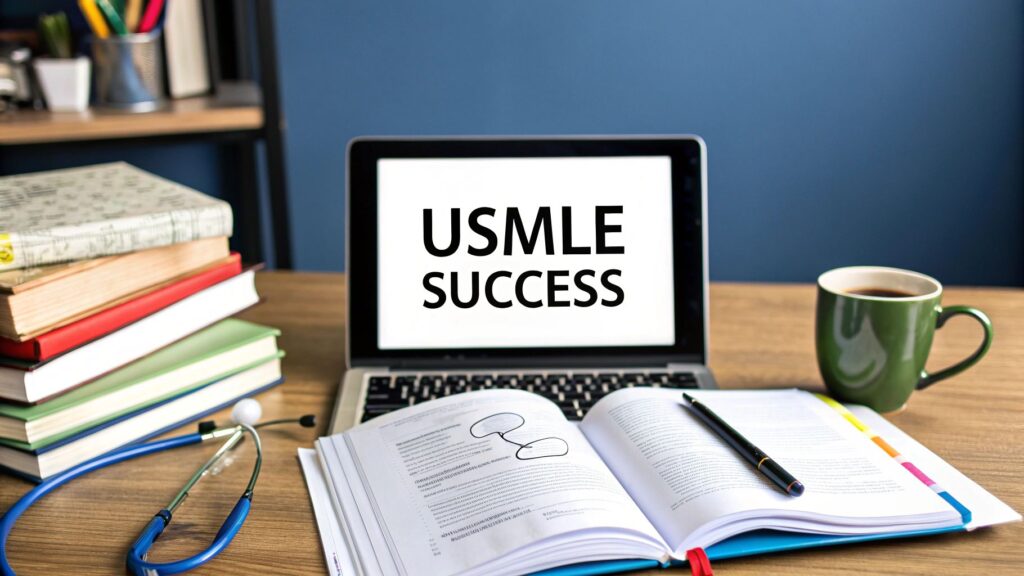Getting ready for USMLE Step 1 is about more than just cramming facts. It’s a marathon that boils down to three core pillars: building a realistic study schedule, zeroing in on high-yield resources, and hitting question banks—hard. Your success hinges on weaving together solid content knowledge with the active recall that only comes from constant practice, all while keeping yourself from burning out.
This is your roadmap to passing one of the most important exams of your medical career.
Your Foundational Step 1 Study Blueprint

Even though Step 1 is now pass/fail, throwing together a study plan at the last minute just won't cut it. Your first move should be to create a solid blueprint. This isn’t about some magic formula; it's about building a sustainable framework that guides you from day one of prep all the way to test day. A well-thought-out plan gives you structure, dials down the anxiety, and ensures you cover everything without feeling like you're drowning.
At its heart, your blueprint needs to balance two critical activities:
- Content Review: Methodically working through high-yield materials like First Aid and Pathoma to build and shore up your foundational knowledge.
- Active Recall: Constantly hitting practice questions to sharpen your information retrieval and clinical reasoning. It’s one thing to know it, another to apply it.
The Impact of the Pass/Fail System
The exam’s format changed in 2022, but the need for serious, structured prep hasn't budged. In fact, the statistics tell a compelling story about why a solid plan is so critical.
The table below gives a snapshot of the 2023 pass rates, showing how performance varies across different groups of test-takers.
| USMLE Step 1 Pass Rate Overview (2023) | |
|---|---|
| Candidate Group | Pass Rate |
| Overall Pass Rate | 87% |
| MD Degree Holders | 94% |
| DO Degree Holders | 92% |
| International Medical Graduates (IMGs) | 74% |
These numbers make it clear: while the overall pass rate of 87% is an improvement from 2022's 82%, it's still lower than the pre-pass/fail era. The gap is even more pronounced for IMGs, who had a 74% pass rate compared to the 94% and 92% for MD and DO students. This data screams that a methodical, well-executed study plan is non-negotiable for success.
Key Takeaway: Don't let "pass/fail" lull you into a false sense of security. This exam still demands a deep, integrated command of the basic sciences. A failing score means a mandatory 60-day waiting period, which can throw a major wrench into your timeline and career progression.
Structuring Your Initial Plan
First things first: map out your timeline. Are you working with a six-week dedicated period, or are you spreading your prep out over several months? Either way, your schedule has to be realistic. Start by blocking off your non-negotiables—classes, clinical duties, family commitments, and your own sanity breaks.
From there, carve up your study time into manageable chunks. A classic approach is to tackle one or two organ systems per week. You could blend content review in the morning with practice questions in the afternoon. For example, a cardiology week might look like mornings spent on physiology and pathology, followed by a 40-question block of cardio questions from your QBank.
To really level up your plan, think about incorporating adaptive learning strategies that adjust based on your performance data. This lets your plan evolve as you get stronger and your weak areas become clearer.
If you’re looking for a more detailed, week-by-week framework to get you started, our comprehensive https://acemedboards.com/usmle-step-1-study-plan/ provides exactly that. Having a structured approach like this builds confidence and makes sure you’re systematically hitting all the material you need to.
Building Your High-Yield Resource Toolkit
The sheer number of USMLE Step 1 resources can feel paralyzing. If you try to use everything, you'll master nothing. The real key is to build a lean, powerful, and integrated toolkit that works for you, not against you.
Think of it like this: you're building a small, elite special ops team, not a sprawling, disorganized army. The goal is to pick a few core components and make them communicate seamlessly. This creates a study ecosystem where an insight from one resource reinforces and deepens your understanding in another.
The Core Trio: UFAP
For years, the foundation of successful Step 1 prep has rested on a powerful trio of resources, often nicknamed "UFAP." These are your non-negotiables—the must-haves that provide the bedrock of your content review and active learning.
- UWorld: This is your primary question bank (QBank). But don't just think of it as a testing tool; it's arguably your most important learning tool. The explanations are absolute gold.
- First Aid for the USMLE Step 1: Consider this your central nervous system for studying. It’s a high-yield encyclopedia of nearly everything you need to know.
- Pathoma: Dr. Sattar provides an exceptionally clear and high-yield review of pathology, a subject that makes up a massive chunk of the exam.
The real magic happens when you get them to work together. For instance, after grinding through a block of UWorld cardiology questions, don't just read the explanations and move on. Physically open First Aid to the cardiovascular section and annotate it with key insights, diagrams, or mnemonics from the UWorld explanations.
This process turns a passive review book into a personalized, living study guide. When you review that First Aid chapter later, you're not just re-reading dry facts; you're re-engaging with concepts that you actively struggled with on practice questions.
This integrated approach is fundamental to how to prepare for USMLE Step 1 effectively. It creates a powerful feedback loop where your QBank performance directly strengthens your foundational knowledge base. Our guide on how to study for USMLE Step 1 digs deeper into creating these feedback loops.
Adding Key Supplementary Resources
While the core trio is essential, a few well-chosen supplementary resources can fill specific gaps and cater to different learning styles. The keyword here is selective. You don't need all of them, but adding one or two can make a world of difference.
Visual and Auditory Learning Tools
Some concepts, particularly in microbiology and pharmacology, are notoriously brutal to memorize from text alone. This is where visual learning platforms really shine.
- Sketchy: This platform uses memorable, story-based cartoons to teach microbiology, pharmacology, and pathology. For a student struggling to keep all the different bacteria straight, a bizarre SketchyMicro video can provide the mental hooks that make the facts finally stick. It's weird, but it works.
- Boards and Beyond: Dr. Ryan's video lectures systematically go through First Aid, explaining concepts in much greater detail. It's fantastic for building a solid foundation before you dive headfirst into the complexity of UWorld questions.
Spaced Repetition with Anki
Anki is a powerful flashcard program that uses a sophisticated algorithm for spaced repetition. It's designed to show you specific facts right before you're about to forget them, making it an incredibly efficient way to lock information into your long-term memory.
Many students use pre-made decks, like the famous AnKing deck, which is meticulously tied to First Aid, Pathoma, and Sketchy. This creates a potent, interconnected system.
Imagine this workflow: you watch a Sketchy video on Staphylococcus aureus, review the corresponding page in First Aid, and then do your daily Anki cards that quiz you on those exact concepts. This multi-modal attack cements the information from multiple angles, making it nearly unforgettable.
A Smarter UWorld QBank Strategy

So many students treat their UWorld QBank like the final boss in a video game. They see every percentage point as a final judgment on their progress, and it creates a ton of unnecessary anxiety. This is completely the wrong mindset.
Your QBank is the single most important learning tool you have—way more powerful than any textbook or video lecture. The very first thing you need to do is shift your perspective from "testing" to "training." That's how you unlock its real potential.
Forget about your percentage correct, especially when you're just starting out. What truly matters is the deep, active learning that happens when you review. Every single question, right or wrong, is a golden opportunity to cement a concept, connect a clinical finding, or pinpoint a knowledge gap you didn't know you had. This is the absolute core of preparing for USMLE Step 1.
Tutor Mode vs. Timed Mode
The debate over tutor versus timed mode is endless, but the answer is actually pretty simple: you need to use both, but strategically.
Early in your prep, especially when you're making your first pass through a subject, tutor mode is your best friend. It lets you see the explanation immediately after you answer, creating a powerful, instant connection between the question's clinical vignette and the underlying science.
As you get closer to your dedicated study period, you must transition to doing your blocks in timed mode. This does two critical things for you:
- It builds your pacing and time management skills, getting you ready for the real deal.
- It simulates the mental fatigue and pressure of an 8-hour exam day. You need to train for that marathon.
The best approach is to do most of your initial, subject-specific blocks on tutor mode. Then, switch to doing nearly all of your random, mixed blocks on timed mode. This builds both your knowledge base and your test-taking stamina at the same time.
The Art of Reviewing a Question Block
This is where the magic happens. A passive review is a complete waste of your time. You need an active, systematic approach for every single block you do. Plan to spend at least as much time reviewing a block as you did answering it—and often, you'll need even more.
For every single question, you have to be able to explain:
- Why the correct answer is correct. Don't just nod along with the explanation. Say it out loud in your own words. Go back and connect it to the specific clues in the question stem.
- Why every incorrect answer is incorrect. This is arguably even more important. Understanding the distractors forces you to differentiate between diseases or drugs that sound frustratingly similar. This is what separates a passing score from a failing one.
Do not move on from a question until you have truly mastered the concept behind it. If a UWorld explanation makes everything click, screenshot it or create a quick Anki card. This turns passive reading into an active learning exercise that pays massive dividends on test day.
Leveraging Performance Data to Hunt Down Weaknesses
UWorld's analytics are like a personalized treasure map leading directly to your weak spots. You need to get in the habit of regularly checking the "Performance" tab to see which subjects and systems are dragging down your score.
Don't just see "Cardiology – 55%" and feel defeated. Dig deeper. Is it cardiac pharmacology? Embryology? Maybe it's just valvular diseases? UWorld's data lets you pinpoint these specific areas with incredible precision.
Once you find a weakness, attack it head-on. Do a small, targeted block of 10-20 questions on just that topic. Watch a relevant Pathoma or Boards and Beyond video. This data-driven approach ensures you're spending your limited time where it will have the biggest impact.
Even though the exam is now pass/fail, this rigorous approach is more important than ever. Since the 2022 switch, first-time pass rates have dipped slightly, with about 90% of students passing on their first try. The factors that consistently separate passing students are diligent self-assessment and using question banks to simulate real test conditions. It all comes back to having a structured, intelligent plan. You can find more about these post-2022 trends and study advice from the American Medical Association.
Designing Your Dedicated Study Schedule
Alright, let's talk about the "dedicated" study period. This is the final, intense push before you sit for Step 1. Honestly, having a smart, sustainable schedule isn't just a good idea—it's completely non-negotiable. This is where you pull all the threads together, shifting from learning foundational knowledge to pure, focused execution.
A solid schedule is your best defense against burnout. It ensures you walk into the testing center at your absolute peak. The whole point is to build a daily and weekly routine that works with your natural energy levels, not against them. Forget those one-size-fits-all templates you see online. You need a system you can actually stick to for weeks without falling apart.
To Block or To Interleave? That Is the Question
One of the first big decisions you'll make is how to structure your daily content review. The two main philosophies are subject blocking and interleaving (which is just a fancy way of saying random, mixed-subject review). Both have their place, and frankly, the best approach is usually a hybrid of the two.
Subject Blocking: This is pretty straightforward. You dedicate a chunk of time—maybe a few hours or even a whole morning—to one subject. Think cardiology, renal physiology, you name it. This method is fantastic for deep dives and patching up major weaknesses you’ve found on your practice exams. For example, if your last NBME showed you're struggling with neurology, you might dedicate your mornings for the next three days to hitting neuro hard.
Interleaving (Random Blocks): This is all about mimicking the real exam. You do mixed-subject question blocks, jumping from endocrine to biostats to anatomy, just like you will on test day. This is the superior method for building the mental agility you need. It forces your brain to retrieve information without the comfort of context clues, which is exactly what strengthens long-term memory.
So, how do you combine them? A popular and effective strategy is to use subject blocking for your morning content review, and then in the afternoon, tackle a random, timed 40-question block from a Qbank like UWorld. This gives you the best of both worlds every single day: deep learning and exam simulation.
The image below gives you a bird's-eye view of how you might allocate your time throughout the week. It’s all about balancing new learning with relentless practice and review.

As you can see, the bulk of your week is dedicated to active studying and practice exams, with a smaller—but absolutely critical—slice reserved for targeted review.
Putting It All Together: A Sample Weekly Layout
Let's get practical. A sustainable schedule usually involves 8-10 hours of focused study per day. Let me repeat: focused. Trying to be a hero and push for 14-hour days is a recipe for disaster. You'll hit a wall of diminishing returns, and your retention will plummet.
Here’s a look at what a typical, effective day during your dedicated period could look like.
| Time Slot | Activity | Purpose |
|---|---|---|
| 8 AM – 12 PM | Content Review (e.g., Pathoma, First Aid, Boards and Beyond) | Targeted deep dive into a weak area. |
| 12 PM – 1 PM | Lunch & Real Break | Rest and refuel. Do not skip this. |
| 1 PM – 3 PM | Timed, Random UWorld Block (40 Qs) & Review | Simulate the exam and find your knowledge gaps. |
| 3 PM – 5 PM | Deep QBank Review / Anki | Master the concepts from the questions you just did. |
| 5 PM – 6 PM | Light Review / Plan Tomorrow | Skim high-yield notes and map out the next day. |
| Evening | OFF | Exercise, eat a good meal, see another human. Protect your sanity. |
This is just a starting point. If you’re a night owl, flip it. The specific times don't matter as much as consistency and balance.
Expert Insight: Your brain cannot effectively consolidate memory without rest. Treating your evenings and at least one full day a week as sacred, study-free time is not a luxury—it's a core component of an effective study strategy. Burnout is the enemy of retention.
Once a week, usually on a Saturday, you’ll swap out this daily routine to take a full-length practice exam. This could be an NBME Self-Assessment or a UWorld Self-Assessment (UWSA). You must do this under strict, timed conditions to build the mental and physical stamina for the real 8-hour test day.
The next day is for reviewing that exam—every single question—followed by a much-deserved half-day or even full day off. This rhythm of intense focus followed by genuine rest is what will carry you through dedicated. It’s how you arrive on test day knowledgeable, practiced, and mentally ready to crush it.
Using Self-Assessments to Guide Your Prep
Think of National Board of Medical Examiners (NBME) Self-Assessments as your personal roadmap through Step 1 prep, not just practice runs. They are the single best predictor of your readiness and the key to unlocking targeted, efficient improvement. Honestly, using them strategically is one of the most critical parts of preparing for this exam.
These exams are your secret weapon. They push you past the gut-wrenching anxiety of a single score and hand you a detailed breakdown of your performance. This is exactly how you find—and fix—knowledge gaps before they become a real problem on test day.
Establishing a Strategic Timeline
Don't just take practice exams whenever you feel like it. That's a rookie mistake. Spacing them out provides a clear, objective picture of your progress over time, allowing you to see if your study strategies are actually working.
Here’s a timeline that has worked for countless students:
- Baseline Assessment: Take your first NBME before your dedicated study period kicks off. This gives you an unfiltered look at your starting point and helps you build a smart, targeted study plan from day one.
- Mid-Point Check-in: Schedule another NBME about halfway through your dedicated period. This is a crucial reality check to see if your methods are paying off and to pinpoint any new weak spots that have emerged.
- Final Check-in: Take your last practice test, often the Free 120 offered by the NBME, about 5-7 days before your actual exam. This is all about building confidence and getting into the test-day rhythm without causing last-minute burnout.
This structured approach transforms practice tests from stressful hurdles into powerful diagnostic tools. You'll be able to sharpen your focus as you get closer to the finish line, putting your energy exactly where it needs to go.
Performing a Deep-Dive Review
Getting your score back is just the beginning. The real learning, the part that actually boosts your score, comes from a meticulous, deep-dive review of your results. You have to move past the three-digit score and dig into the performance data broken down by system and discipline.
Key Insight: A low score in Pharmacology isn't a dead end; it's a signpost. Does the data show you're weak specifically in autonomic drugs or antimicrobials? This level of detail lets you perform surgical strikes on your weaknesses instead of wasting time re-reading entire subjects you've already mastered.
After each exam, block out several hours—yes, hours—to review every single question. This means understanding not only why your correct answers were right but, more importantly, dissecting why each distractor for the questions you missed was wrong. This process builds the kind of nuanced understanding that separates a passing score from a great one.
Simulating Test-Day Conditions
Let's be real: the USMLE Step 1 is an 8-hour marathon. Building the mental and physical stamina to perform under that kind of pressure is just as important as knowing the Krebs cycle. For this reason, you must take every single self-assessment under strict, simulated test-day conditions.
This means:
- Starting at the same time your real exam will begin.
- Taking only the breaks you're allotted.
- Putting your phone away and telling your roommates to leave you alone. No excuses.
The goal is to make the real test day feel like just another practice session. This builds resilience, systematically dismantles test-day anxiety, and gives you a true measure of your readiness.
This data-driven approach is especially crucial for some students. For instance, 2023 performance data shows that while first-time US/Canadian MD candidates have a 92% pass rate, repeat test-takers have a pass rate of only 70%. The gap is even wider for non-US/Canadian graduates repeating the exam, with a pass rate of just 47%.
These numbers aren't meant to scare you; they're meant to be a wakeup call. They highlight that preparation, especially for a retake, must be guided by rigorous self-assessment to identify and correct the specific issues that led to a previous failure. You can review the complete USMLE performance data yourself to explore these statistical trends.
Common Questions About Step 1 Prep

As you get deeper into the Step 1 grind, it's totally normal for certain questions and anxieties to start bubbling up. Let's tackle some of the most common concerns we hear from students, cutting through the noise to give you direct, practical answers that will help you stay on track and keep your confidence high.
How Long Should I Study for USMLE Step 1?
There isn't a single magic number here, but a winning timeline usually unfolds in two distinct phases. The first is a slow-and-steady review that you weave into your second year of med school—maybe an hour or two each day. The second phase is the intense, all-in "dedicated" period.
For most students at U.S. medical schools, this dedicated study period lasts about 6 to 8 weeks, where you're putting in 8-10 hours of focused work every day. For international medical graduates (IMGs), this runway is often a bit longer, usually somewhere between 6 to 12 months. This extra time is crucial for bridging any gaps in foundational knowledge and getting comfortable with the unique style of USMLE questions.
Ultimately, the best timeline is the one you can actually stick to without burning out. This exam is a marathon, not a sprint. A well-paced, sustainable schedule is your best defense against the mental exhaustion that will inevitably try to creep in.
What Is a Good Score on a UWorld or NBME Practice Exam?
With Step 1 now being pass/fail, your goal isn't to chase a specific three-digit score but to confirm your readiness. Practice exams are your best tools for gauging this.
So, what should you be looking for?
- UWorld QBank: Consistently hitting above 65-70% on random, timed blocks of 40 questions is a fantastic sign that you're in a great spot.
- NBME Self-Assessments: Scoring 65% or higher is a solid benchmark. Hitting this mark usually correlates with a >95% probability of passing the real deal.
The most critical thing to watch is the trend. Are your scores steadily climbing as you move through your dedicated period? A single bad score is just a data point, so don't panic. But a consistent pattern of low scores is a signal to take a step back, re-evaluate your study methods, and get more aggressive about tackling your weaknesses.
How Many Times Should I Go Through UWorld?
Let’s be clear: the quality of your review will always be more important than the quantity of your passes. Most students who do really well complete one single, thorough pass of the UWorld QBank. And by "thorough," I mean deeply analyzing every single question and its explanation—especially the ones you got right.
If you decide to do a second pass, you need to change your strategy. Don't just reset the whole bank and do it all over again. A much smarter approach is to focus only on your incorrect and marked questions. This creates a powerful, high-yield review that directly targets your specific weak points.
Some students even skip a full second pass entirely. Instead, they create flashcards (using a program like Anki) based on the concepts from their incorrects. This ensures you're actually mastering the underlying principles, not just memorizing the answer to a question you've already seen.
What Should I Do the Week Before the Exam?
The final week is all about two things: consolidation and mental prep. It is absolutely not the time to cram new information. Your goal is to walk into that testing center feeling rested, confident, and sharp.
Your study habits should shift to light, rapid-review activities. Think about:
- Skimming through your personalized notes and annotations in First Aid.
- Quickly running through your most high-yield flashcard decks (like your UWorld incorrects).
- Flipping through the rapid review sections at the back of your main textbooks.
Many students like to take a final practice exam, like the Free 120, early in the week to get one last simulated experience. But it's critical to start tapering your studying in the last 2-3 days.
The day before your exam should be 100% study-free. I'm serious. Go for a walk, watch a movie, have a nice dinner with a friend. At this point, a full night of sleep is infinitely more valuable than another hour of frantic review. Protecting your mental health is paramount, and it's important to recognize the signs of USMLE exam burnout to avoid derailing your hard work.

